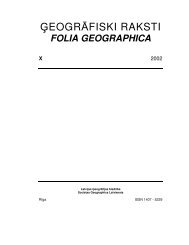eogrÄfiski raksti folia geographica xii - Ä¢eogrÄfijas un Zemes zinÄtņu ...
eogrÄfiski raksti folia geographica xii - Ä¢eogrÄfijas un Zemes zinÄtņu ...
eogrÄfiski raksti folia geographica xii - Ä¢eogrÄfijas un Zemes zinÄtņu ...
You also want an ePaper? Increase the reach of your titles
YUMPU automatically turns print PDFs into web optimized ePapers that Google loves.
17<br />
NATURE RESEARCH<br />
Figure 1. The approximate bo<strong>un</strong>dary of the ecotone between the European boreal and nemoral zones (dashed line).<br />
Isopleths of annual temperature ranges in Fahrenheit degrees, with Celsius equivalents in parenthesis after<br />
R. C. Scott [1992].<br />
2. Data and methods<br />
To describe the division of the year into seasons and to trace the diachronous nature of<br />
and links between the seasons, a comparative study of net radiation, air temperature,<br />
atmospheric precipitation, air mass types and the state of vegetation was carried out, taking into<br />
consideration the diurnal rhythms and interannual variations. While the annual course of<br />
different air mass types is usually left beyond the scope in such kind of studies here it is<br />
followed up. For this purpose, the observation data for a 11-year period (1990-2000) were<br />
extracted at the Latvian Hydrometeorological Agency, and long-term means were considered,<br />
too (Table 1).<br />
Net radiation is defined as the difference between the gain through incoming short-wave<br />
solar radiation and loss through reflected short-wave and emitted long-wave or terrestrial<br />
radiation. In Latvia, actinometric observations, including net radiation measurements, are<br />
carried out only in one station, yet the observation station site has been relocated three times.<br />
For a long time (1948-1972) the station was located in Riga (56º58´N, 24º02´) and the longterm<br />
means of net radiation used in this study have been calculated after the measurements<br />
made in this site. Since 1991, after relocation from Zoseni (57º09´N, 25º54E´, Vidzeme upland),<br />
the station is located in Zilani (56º31´N, 25º´55 E, on the Daugava). Unfort<strong>un</strong>ately, a<br />
considerable number of data gathered during the 11-year period of the study were rejected due<br />
to low-quality and even missing measurements. As result, the authors used for this study the<br />
data for 6 years (1986-1988, Zoseni, 1994-1996 Zilani).<br />
Air masses were determined for the 11-year period using twice-a-day (00 UTC and<br />
12 UTC) upper air observation data for Riga and also Liepaja (till 1992). M.Geb’s [1971]<br />
method, which is based on climatological identification of air masses at the same time checking<br />
them with respect to their typical heat content (pseudopotential temperature θ850) at 850 hPa<br />
level, was applied. The method implies the analysis of frontal zones and weather systems at that<br />
level. A distinction is made between maritime (m), transformed maritime (x) and continental (c)<br />
air masses, considering that transformation of maritime air into x air requires at least 24 hours.<br />
Transformation of an air mass is caused by several factors, such as surface temperature,<br />
moisture and topography. The type of air mass trajectory, whether cyclonic or anticyclonic, also<br />
has a bearing on its transformation.

















